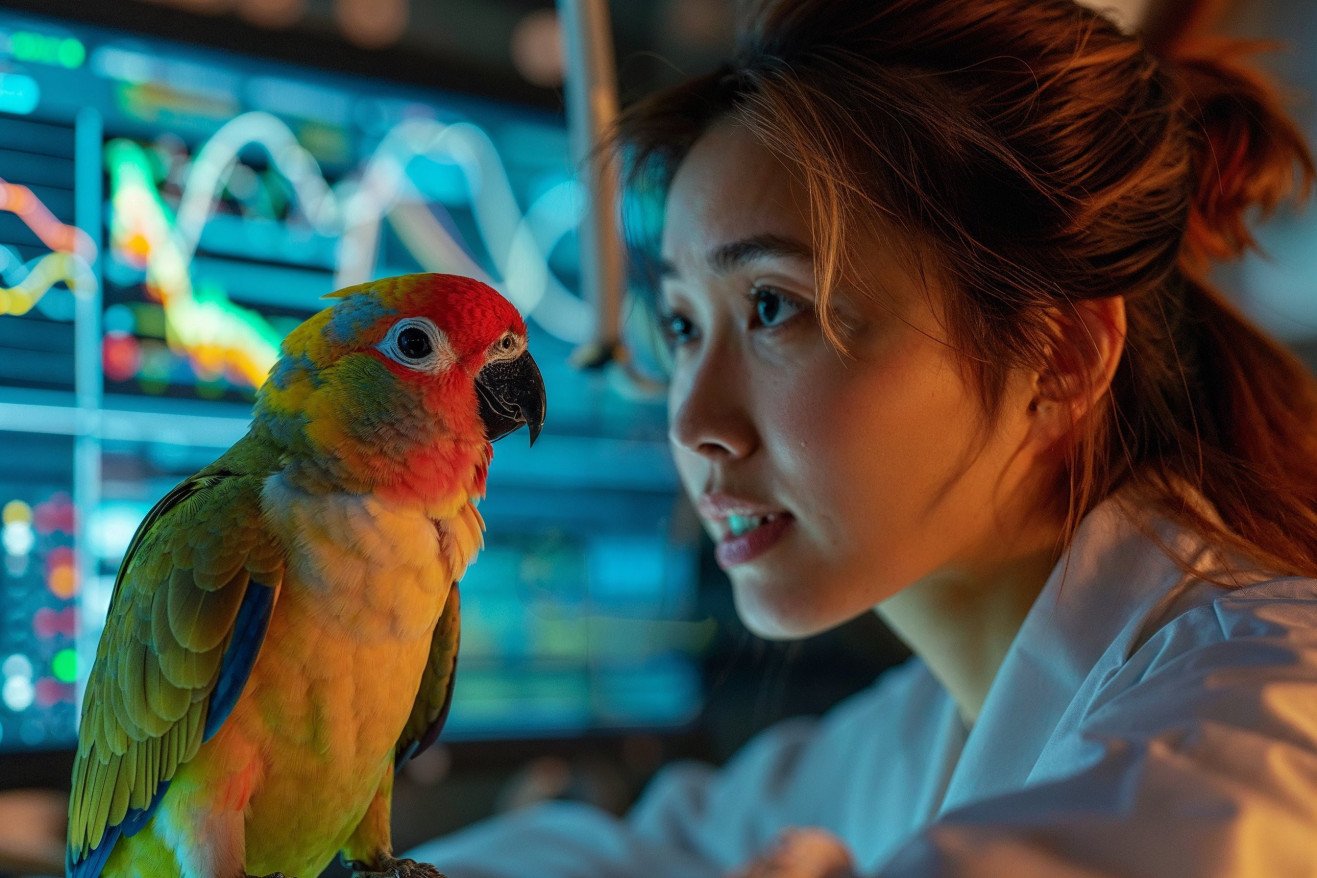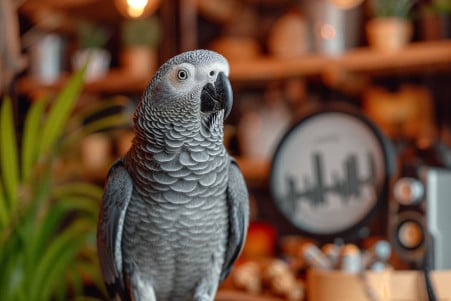Can AI Help Us Understand Animal Communication? The Future of Interspecies Communication
24 January 2024 • Updated 12 February 2024

What if AI could help us communicate with other species? AI is on the verge of changing the way we understand animal communication. With machine learning, projects like the Earth Species Project are on the cusp of creating a system that could lead to two-way communication, and we may be able to understand animal calls and help with conservation in the next 10 years.
In this exciting investigation, we will look at the intersection of AI, linguistics, and biology. We will learn how machine learning and neural networks are being used to make sense of the complex world of animal communication. Along the way, we will cover the ethics, technology, and the collaborations between computer scientists and biologists that are all working to uncover the secrets of animal communication for the benefit of all species involved.
Can AI help us understand animal communication?
Breaking the Code: How AI Is Advancing the Study of Animal Communication
The Earth Species Project (ESP) is the first organization to use artificial intelligence to unravel the complex network of non-human communication. According to The Guardian, ESP is taking a comprehensive approach to decoding the vocalizations of a wide range of animals, from the elaborate songs of whales to the unique calls of primates.
In addition to learning more about these languages, ESP hopes to use its research to help with conservation efforts and plans to make its results open to the public.
This ambitious project has already led to the release of ESP’s first scientific paper, a major accomplishment in the field. The study focuses on the “cocktail party problem,” which is the difficulty of picking out individual voices in a crowd. By creating AI that can separate animal sounds from the rest of the noise, ESP has set the stage for a deeper understanding of animal languages.
Still, there are questions about the potential of AI to capture the full complexity of animal communication, which can be highly dependent on the situation and range from simple to complex.
Despite these concerns, organizations like ESP and Project CETI are moving forward, as The Guardian notes, showing a dedication to expanding our knowledge of the natural world. With further research and technological developments, we may soon be able to not only understand but also communicate with other species.
Cutting-Edge AI Methods in Animal Language Studies
The combination of large language models (LLMs) and self-supervised learning has pushed the study of animal communication to new heights. These state-of-the-art AI techniques are currently being used to help researchers decode the complex vocalizations of animals.
According to ZDNET, LLMs like Google’s Bard and ChatGPT are being trained on large datasets, which allows them to learn and understand linguistic patterns across different species. This is similar to how these models have transformed the study of human language and could soon do the same for animal communication.
Google Cloud has helped speed up this process by providing the Earth Species Project with the computational power needed to train and refine their machine learning models. As Google Cloud Blog explains, this partnership is helping to create new benchmarks and base models that could eventually lead to the creation of synthetic animal sounds, which would make it possible to have conversations with animals.
Still, the lack of foundational data is a major obstacle. To address this, the Earth Species Project is collecting extensive bioacoustic recordings of animals from around the world, using IoT devices to ensure they have a wide range of data. However, the lack of foundational data is still a problem because there is no written record of animal language that can be used to train the models.
As these AI tools continue to be developed and refined, we are getting closer to not only understanding animal sounds but also being able to communicate with animals in their own languages, which could open up a new era of interspecies communication and conservation.
Navigating the Ethics of AI in Animal Communication
The Earth Species Project’s mission to create open-source animal language translation tools is at the forefront of AI’s foray into animal communication. The project’s work in translating prairie dog alarm calls and dolphin whistles is groundbreaking, but it also raises important questions about the ethics of the knowledge it’s creating.
A report by Cryptopolitan found that AI’s integration into animal welfare has the potential to change how we understand and care for animals, as shown by the analysis of cat facial expressions.
Meanwhile, the creation of user-focused apps like MeowTalk has brought data privacy and animal rights concerns to the forefront. Dr. Monica Lopez-Gonzalez has called for a new animal rights framework and even a Geneva Convention for cross-species communication. The SAIS Observer has pointed out that while AI can create the illusion of understanding, ethical interspecies exploration requires human intervention.
The tension between the pursuit of knowledge and the welfare of animals is a difficult one to navigate, and the perspectives of the experts interviewed for this article show the responsibilities and potential pitfalls of AI’s use in this area.
As AI and animal communication continue to intersect, it’s important to keep these ethical considerations in mind to make sure our quest for knowledge doesn’t come at the expense of the dignity and integrity of the natural world.
The Voices of Nature: AI’s Impact on Animal Communication
AI’s integration into the field of ecology has resulted in some amazing breakthroughs in the realm of animal communication. One of the most notable examples is the work done with humpback whales, whose vocalizations, thanks to the recordings made by the military, have been used to both better understand their language and change environmental policy.
In fact, the analysis of these recordings with AI was instrumental in the creation of marine protected areas, according to Big Think.
AI’s impact has also been felt in the analysis of communication across a wide range of animals, from the complex sounds of insects to the low-frequency rumbles of elephants. For example, machine learning was used to identify a unique population of blue whales in the Indian Ocean, proving that AI can be a game-changer in the study of biodiversity.
These examples are just a few of the ways that these technologies are being used in the real world, including AI’s use in Costa Rican rainforests to assess reforestation efforts by analyzing the soundscape. According to Scientific American, AI models can now even separate and interpret individual animal vocalizations, which can help conservationists better understand the impact of human-generated noise on animals.
When we consider these breakthroughs, it’s easy to see that AI’s ability to understand the language of the natural world is changing the way we approach conservation and our relationship with the environment. And the fact that these AI tools are being used in practical ways in the field is a sign that the future of technology and the environment may be more harmonious than we think.
The Challenge of Animal Minds: AI’s Decoding Dilemma
The challenge of using AI to uncover the complexities of animal communication is daunting. One of the biggest hurdles is the cognitive and perceptual differences between species, which mean that animals experience the world in ways that are completely different from humans.
The New Yorker writes about the “Doctor Dolittle challenge,” which notes that the translation of animal communication is difficult when the species involved don’t have the same basic perceptual and cognitive processes.
Our human concepts are used to understand the world, but they don’t necessarily apply to the acoustic landscapes and sensory worlds of animals like dolphins or bats.
Moreover, the lack of standardized measures in animal communication studies and the resulting lack of data make the task of AI even more difficult. As Last Week in AI points out, studies have shown that the complex and diverse nature of animal communication signals often can’t be captured by current AI models, which are based on human language.
Beyond these technical challenges, a Philosophy & Technology article notes that AI technologies could have a number of negative impacts on animals, from direct to unintended consequences. This systematic review calls for a careful consideration of the unintended consequences that AI could have on animal well-being.
As we push the boundaries of AI’s ability to decode animal communication, it’s important to meet these challenges head-on to make sure that our technological efforts don’t come at the expense of the well-being of the animals we’re trying to understand.
Toward the Future: AI and the Search for Animal Language
Throughout our investigation into AI’s quest to decode animal language, we have seen the potential of projects like the Earth Species Project, which uses machine learning to translate the detailed vocalizations of the many species that inhabit our planet. From the humpback whale’s eerie songs to the prairie dog’s multifaceted warning calls, AI is just starting to uncover the multifaceted world of non-human communication, providing new ways to understand the natural world.
AI also has the potential to help humans communicate with other species. As we continue to develop large language models and self-supervised learning, we are getting closer to not just understanding but talking with animals. This could transform conservation, deepen our understanding of the environment, and enhance our relationship with the other species we share the planet with.
However, as we move forward, we need to make sure that we use our technological advances responsibly. We need to make sure that animals are protected and their rights are preserved as we move into the era of AI-driven exploration.
As we wrap up, it’s important to note that the future of AI and animal language decoding will depend not just on technological breakthroughs but also on the ability to encourage interdisciplinary work and responsible development.
By bringing together computer scientists, linguists, biologists, and ethicists, we can continue to push the boundaries of what we know while respecting the natural world we are trying to learn more about. The road ahead is full of promise and uncertainty, and it will be guided by the collective knowledge and respect for all living things.


